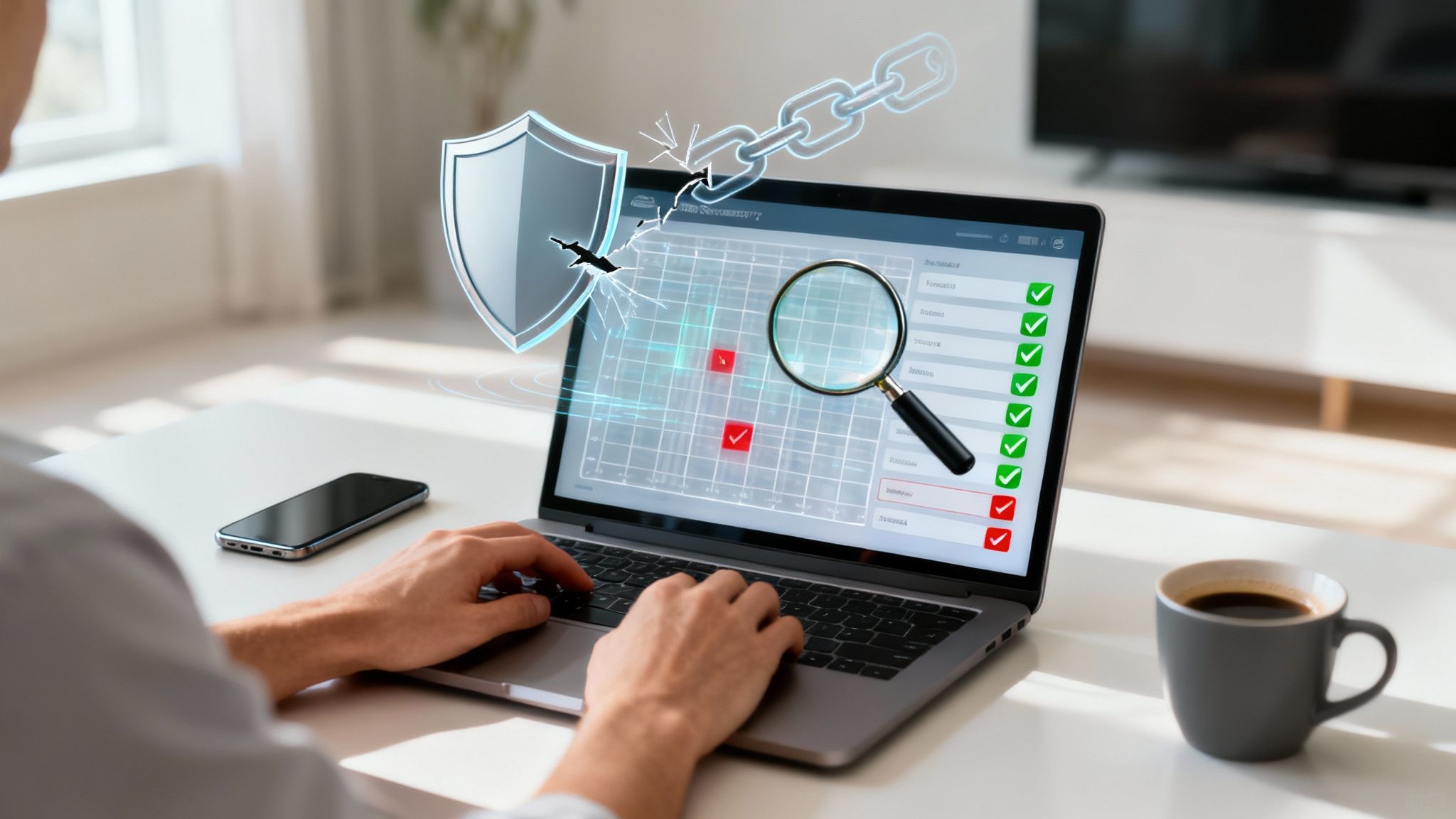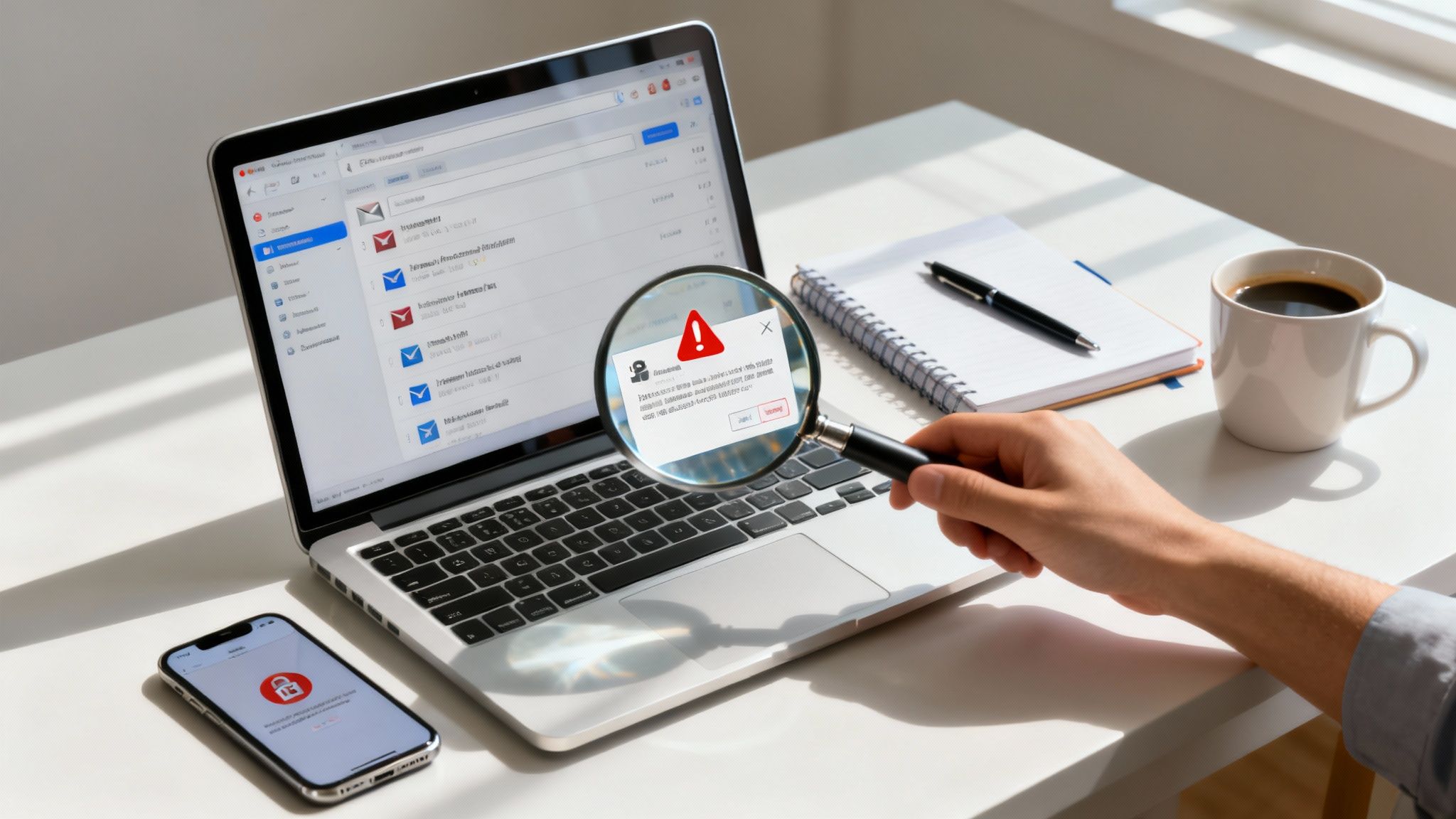· Digital Footprint Check · Content Marketing · 19 min read
Using a Personal Data Leak Checker
Is your data exposed online? Learn how to use a personal data leak checker to find out and what critical steps to take to secure your digital identity.

Ever heard of a personal data leak checker? It’s a tool that digs through the good, the bad, and the ugly parts of the internet—including the dark web—to see if your personal info has been exposed in a data breach. We’re talking emails, passwords, phone numbers, the works.
Think of it as an early warning system for your digital life. It’s the first line of defense in spotting your vulnerabilities before a cybercriminal does.
Your Digital Footprint and Its Hidden Risks

Before you even think about running a scan, it’s worth taking a second to understand what a personal data leak really means. It’s not just about a single lost password. It’s about pieces of your identity floating around in the wild, completely out of your control.
Every time you sign up for a newsletter, buy something online, or post on social media, you leave little bits of data behind. All those bits and pieces add up to create your digital footprint. If you’re curious about just how big your own footprint is, our guide on understanding your digital footprint is a great place to start.
When a company you’ve trusted gets hacked, those little bits of your footprint get stolen. A leaked email address might not sound like a big deal, but to a criminal, it’s gold. It’s the first thread they can pull to unravel your entire online presence, often starting with targeted phishing attacks designed to trick you into giving up the really important stuff, like banking details.
The Domino Effect of a Single Leak
Let’s play out a common scenario. A small online forum you signed up for years ago gets breached. The attackers grab your old email and a password you’ve probably reused on a dozen other sites. Suddenly, they have a key that might unlock your primary email, your Amazon account, or worse.
This is the domino effect in action. One tiny, forgotten compromise can easily cascade into a massive security nightmare.
And this isn’t a rare occurrence. The scale of this problem is staggering. In the U.S. alone, there were over 3,100 reported data breaches in a single recent year, impacting more than 1.35 billion people across the globe. These numbers, highlighted by industry trackers like Secureframe, show just how routine this has become. Using a data leak checker isn’t a paranoid, one-off task; it’s just basic maintenance for anyone living online today.
What Criminals Are Really After
Cybercriminals aren’t just hoarding passwords for fun. They’re building detailed profiles on people—using bits of data stolen from different breaches—to carry out sophisticated fraud and identity theft.
Let’s break down the kinds of information they’re hunting for and why.
Common Types of Compromised Personal Data
The table below summarizes the data most often stolen in breaches. It’s not just about the data itself, but what an attacker can do with it that makes it so dangerous.
| Data Type | What It Is | How Criminals Use It |
|---|---|---|
| Email Address | Your main online ID and the recovery point for almost every account you own. | Phishing attacks, spam campaigns, and to test for access on other platforms. |
| Passwords | The keys to your various online services. | To directly access your accounts or use in credential stuffing attacks on other sites. |
| Phone Number | A direct line to you, often used for two-factor authentication. | SIM-swapping attacks, smishing (SMS phishing), and social engineering calls. |
| Full Name & Address | Core pieces of your real-world identity. | Identity theft, opening fraudulent accounts, or sending physical mail scams. |
The key takeaway here is that these pieces of information become more powerful when combined. An attacker might not be able to do much with just an old password, but pair it with your full name and phone number from another breach, and suddenly they have everything they need.
The real danger isn’t just the data itself, but the connections between different pieces of information. A name, email, and old password from one breach can be combined with a phone number from another, creating a powerful toolkit for an attacker.
Choosing the Right Data Leak Checker
Not all data leak checkers are created equal. Picking a reliable one is the first critical step to getting a clear, honest picture of your online exposure. The right choice for you really boils down to what you’re looking for: a quick, one-time check or a more hands-off, continuous monitoring system.
You’ll find the landscape is split into two main camps. On one side, you have fantastic free services that are perfect for a quick spot-check. On the other, you’ve got paid, commercial options—often built into password managers or security suites—that keep a constant eye on things for you.
Free and Accessible Checkers
If you’re just starting, a free tool is the perfect entry point. These services are beautifully simple. They do one thing and they do it well: they scour massive databases of known data breaches to see if your info has popped up anywhere it shouldn’t be.
The undisputed king of this space is Have I Been Pwned? (HIBP), a respected project run by security expert Troy Hunt. It’s one of the largest and most trusted breach databases available to the public. You just type in your email address and see a list of every known breach it’s been a part of.

The interface is dead simple, which is exactly what you want. No jargon, no confusion—just a straightforward answer to a critical question.
Another great option is Firefox Monitor. It actually pulls its data from HIBP’s database, but if you have a Firefox account, it adds the benefit of ongoing alerts if your details appear in a new breach.
Paid and Integrated Solutions
This is where things get more proactive. Paid services are usually part of a bigger security package, like the breach monitoring features you’ll find in password managers like 1Password or Dashlane.
Their biggest selling point is proactive monitoring. Instead of you having to remember to run a scan every few months, these tools do it for you automatically. They constantly check for your credentials in newly discovered breaches and shoot you an alert the moment they find something. It’s a “set it and forget it” approach to security.
When you’re trying to decide which route to take, a simple comparison can help clear things up.
Feature Comparison of Popular Data Leak Checkers
Here’s a side-by-side look at some leading free and paid data leak checker services to help you choose the best one for your needs.
| Tool Name | Data Checked (Email, Phone, etc.) | Key Feature | Cost |
|---|---|---|---|
| Have I Been Pwned? | Email, Passwords (via Pwned Passwords) | Largest public breach database | Free |
| Firefox Monitor | Continuous monitoring and alerts | Free | |
| 1Password | Email, Passwords, Credit Cards | Integrated directly into your password vault | Paid (Subscription) |
| Dashlane | Email, Passwords | Dark web monitoring and identity alerts | Paid (Subscription) |
Ultimately, the best service depends entirely on your personal security habits and how much you’re willing to invest.
My two cents: Free tools are perfect for an initial “Oh no, am I in trouble?” check-up and for periodic scans. Paid services are for people who want automated, continuous protection as part of a larger security strategy.
As you weigh your options, keep these factors in mind:
- Database Size: Is the service pulling from a massive, frequently updated database? The bigger the pond, the more likely you are to find a fish.
- Data Types Checked: Does it only scan for email addresses, or can it also check for compromised phone numbers, usernames, and passwords?
- Ease of Use: You need a clear interface that explains the results in plain English. Technical jargon doesn’t help when you’re trying to figure out what to do next.
For a more comprehensive look at your options, you can explore some of the top tools for monitoring your digital footprint and compare their features in more detail. At the end of the day, the best data leak checker is the one you’ll actually use.
How to Run Your First Data Leak Scan
Alright, enough theory. It’s time to see what’s actually out there. Running your first scan with a personal data leak checker is surprisingly simple, and you absolutely don’t need a technical background to get started.
Let’s walk through it together. My goal is to make you feel completely comfortable checking your own data. By the end of this, you’ll know exactly how to kick off a scan and, more importantly, how to make sense of the results.

Getting Started with Your Scan
First things first, head over to a trusted data leak checker. A great, well-respected starting point is a free service like Have I Been Pwned?. You’ll land on a clean page with one main purpose: a search box waiting for your email address.
This is the key to the whole process. Think of your email address as your unique ID across the web—it’s what you use to sign up for everything from social media to your favorite online stores. When those services get hit by a data breach, your email is almost always the central piece of data that gets exposed.
Go ahead and type your primary email address into the box and hit the button to start the scan. The tool will immediately cross-reference your email against its enormous database of known data breaches. It’s a fast process, usually taking just a few seconds.
A Quick Note on Privacy: You might be hesitant to type your email into a random website, and that’s smart. Reputable checkers don’t store the emails you enter. They perform a live check against their breach database and then immediately discard the query. Stick with well-known services to ensure your privacy is respected.
The information these tools compile often comes from Open Source Intelligence (OSINT) techniques, which is a fancy way of saying they analyze publicly available data from breaches. If you’re curious about the nitty-gritty of how this works, you can dive deeper in our guide to OSINT tools for digital footprint checking.
Understanding the Results Page
Once the scan is finished, you’ll get your results. This is the moment of truth where you find out if—and where—your information has been compromised. Generally, you’ll see one of two outcomes.
“Good news — no pwnage found!” If you get a message like this, breathe a small sigh of relief. It means the checker didn’t find your email address in its database of publicly known breaches. It’s a great result, but remember, it only covers incidents that have been discovered and cataloged.
“Oh no — pwned!” This is the message you’ll get if your email address appeared in one or more data breaches. My advice? Don’t panic. This is incredibly common. A recent study found that a staggering 85% of people have had their data exposed in a breach at some point. You are definitely not alone.
If your email was found, the page will break down every breach it was a part of. For each incident, you should see:
- The name of the breached company (e.g., Adobe, LinkedIn, MyFitnessPal).
- The date of the breach, which helps you establish a timeline.
- A list of the specific data types compromised in that event (e.g., email addresses, passwords, usernames, geographic locations).
This breakdown is the most important part. It tells you exactly which of your accounts were affected and precisely what kind of information was stolen. This is the critical first step toward locking down your digital identity.
Making Sense of Your Scan Results
Okay, so you ran a scan and your email showed up on a breach list. That feeling in your stomach? Totally normal. It feels like a punch to the gut, but this isn’t the time to panic. It’s time for calm, focused action. Think of those scan results as a roadmap—they show you exactly where the weaknesses are so you can start shoring up your defenses. Learning to read that map is the first step.
When you look at the results, you’ll probably see some weird jargon like “pwned” or “paste.” “Pwned” is just hacker-speak for “owned,” meaning your data was found in a known data breach. A “paste” is a little different; that’s when collections of data, usually email and password combos, get dumped onto public sites like Pastebin. Both are a clear signal: your information is out there.
The trick is not to get overwhelmed by a long list of breaches. Your only job right now is to figure out what needs fixing first.
Creating Your Action Plan
Let’s be real: not all breaches are created equal. A data leak from that silly online game you played a decade ago is way less urgent than a breach at your bank or primary email provider. So, the first thing you need to do is triage the results based on how sensitive the account is.
Scan the list for names you recognize and ask yourself a few key questions:
- Does this involve money? Anything tied to banking, credit cards, or payment apps like PayPal immediately goes to the top of the list. No exceptions.
- Is this my main email account? This is a big one. Your primary email is the master key to your entire digital life. If a hacker gets in, they can start hitting that “Forgot Password” link on all your other services.
- Is this a major shopping or social media account? Think about sites where you’ve stored your credit card or a lot of personal info, like Amazon, Facebook, or LinkedIn.
- Is this an old account I completely forgot about? While these might seem low-risk, they’re a problem if you reused that same password anywhere else. These still need to be dealt with, just not right this second.
By sorting the list this way, you turn a scary wall of text into a manageable to-do list. Now you know exactly where to start.
If there’s one thing to take away from a breach scan, it’s this: context is everything. A breach exposing your social security number is a five-alarm fire. A breach that only leaked an old username? That’s more of a smoldering cigarette butt. Prioritization is your best friend here.
Immediate Remediation Steps
Once you’ve identified your high-priority accounts, it’s time to move. The goal is to make the stolen information useless to criminals and build stronger walls around those accounts.
For each high-priority account on your list, follow these steps:
- Change the Password. Now. This is non-negotiable. Go to the site, and create a brand new, unique, complex password. Don’t just add a “1” to the end of your old one. Never, ever reuse it again.
- Hunt Down Reused Passwords. This is the most critical follow-up. If you used that compromised password on any other site, those accounts are now wide open, too. A good password manager is a lifesaver here; many have a built-in tool that scans your saved logins for reused or weak passwords.
- Turn On Two-Factor Authentication (2FA). Seriously, this is the single most powerful security upgrade you can make. 2FA adds a second layer of security, usually a code from an app on your phone, that’s required to log in. Even if a thief has your password, they can’t get in without your phone.
Taking these steps is so important because most breaches succeed due to simple human mistakes. Research shows that attacks using stolen credentials (credential abuse) were behind 22% of incidents, while phishing tricked people into giving up their info in another 16% of cases. You can dig deeper into how human error plays a role in data breaches if you’re curious. By fixing your passwords and enabling 2FA, you’re directly fighting back against the most common ways hackers get in.
Building a Proactive Digital Defense

Running a personal data leak check is a great step, but it’s fundamentally reactive. You’re cleaning up a mess that’s already been made. True digital safety comes from being proactive—building habits that stop your data from getting caught in a breach in the first place.
It’s about shifting your mindset from cleanup to defense. The goal is to make yourself a much harder, less appealing target for attackers.
This all starts with the basics, and there’s no bigger basic than your passwords. The single most common mistake people still make is reusing the same password across multiple sites. If you’re doing that, a proactive defense is simply impossible. This is where a password manager becomes non-negotiable.
These tools are lifesavers. They generate ridiculously complex, unique passwords for every single site you use and store them securely. All you have to do is remember one single master password to unlock your vault. This one change single-handedly neutralizes the risk of a breach at one company taking down all of your other accounts.
Fortifying Your Logins with Multi-Factor Authentication
Even with a fortress of a password, you’re not done. You need another line of defense, and that’s multi-factor authentication (MFA). You might also hear it called two-factor authentication or 2FA, but it’s the same idea: proving it’s really you with more than just a password.
MFA comes in a few different flavors, each with its own level of security:
- SMS-based MFA: You get a code sent to you via text. It’s definitely better than nothing, but it’s the weakest link, vulnerable to tricks like SIM-swapping.
- Authenticator Apps: Apps like Google Authenticator or Authy generate a constantly refreshing, time-sensitive code right on your phone. This is a far more secure and recommended option.
- Hardware Keys: A physical USB key (like a YubiKey) that you plug in or tap on your phone is the gold standard. It’s practically immune to remote attacks.
Time and again, we see major global companies suffer from high-impact data breaches that could have been stopped—or at least minimized—by fundamental security measures. Many of these incidents exploit weak links, like third-party contractors, underscoring just how critical things like phishing-resistant MFA really are. Turn on MFA for every single account that offers it. Prioritize your email, banking, and social media accounts.
Your password proves what you know. Multi-factor authentication proves what you have (your phone or a hardware key). Requiring both makes it exponentially harder for an attacker to break in, even if they’ve stolen your password.
Being Selective with Your Data
A huge part of a proactive defense is simply being more thoughtful about who you give your data to. Before you sign up for that new app or newsletter, stop and ask yourself: “Do I genuinely trust this company to protect my information?” Take a minute to glance at the privacy policy and only ever provide the bare minimum amount of data they require to function.
Here’s a powerful technique I use myself: email aliases. Services like SimpleLogin or even built-in features from iCloud and Fastmail let you create unique email addresses for every online service you sign up for.
If one of those aliases ever starts getting spam or shows up in a data breach alert, you know exactly which service was compromised. Better yet, you can instantly disable that specific alias without touching your real, primary email address. This effectively compartmentalizes your digital identity, containing the damage from any single breach.
Of course, beyond the tools, a strong defense also means understanding the common ways attackers try to trick you, like phishing scams. The more you know, the safer you’ll be. You can learn practical steps for phishing prevention to really round out your proactive security strategy.
Got Questions About Data Leaks? We’ve Got Answers.
Finding out your personal info has been splashed across the internet is unsettling, and it naturally brings up a lot of questions. Getting straight, no-nonsense answers is the first real step toward getting back in the driver’s seat. Let’s walk through some of the most common things people worry about after running a data leak scan.
Can I Get My Leaked Data Taken Down?
This is usually the first question on everyone’s mind, and the honest-to-goodness answer is almost always no. It’s a tough pill to swallow.
Once your information is caught in a data breach, it’s immediately copied, sold, and spread across thousands of servers, forums, and dark web marketplaces. Trying to erase it is like trying to get a drop of dye out of a swimming pool—it’s just everywhere. The goal has to shift from removal to making that stolen data completely worthless. That means changing passwords immediately and turning on MFA everywhere you can.
How Often Should I Check for Leaks?
There’s no single magic number here, but a good habit to get into is running a manual check every three to six months. This keeps you in the loop on any new incidents without having to obsess over it daily.
Of course, this is where automated monitoring services really prove their worth, since they’re doing that legwork for you around the clock.
Is a Paid Monitoring Service Really Worth It?
This brings us to the big one: Should you actually pay for one of these services? While free tools are fantastic for those periodic spot-checks, paid services are all about being proactive. They offer continuous, automated monitoring. Think of it as a smoke detector for your digital life—it scans for new breaches daily and shoots you an alert the moment your info pops up.
Here’s a real-world scenario to consider: A company gets breached in January, but the full extent of it isn’t made public until May. If you’re only doing manual checks, you’ve been exposed for four whole months without knowing it. A paid monitoring service would have likely flagged your data much, much sooner, giving you a critical head start to protect your accounts.
The real value of a paid service isn’t just seeing the leaked data; it’s the peace of mind you get from having automated, constant vigilance. For just a few dollars a month, you’re basically hiring a digital security guard to watch your back 24/7.
Ultimately, it boils down to your own habits. If you’re super diligent and remember to do your manual checks, a free service might be enough. But if you’re looking for that “set it and forget it” layer of protection, a paid subscription provides some serious value.
Ready to take the first step in protecting your digital life? Digital Footprint Check provides comprehensive scanning and real-time alerts to keep your personal information safe. Start your free scan today!



